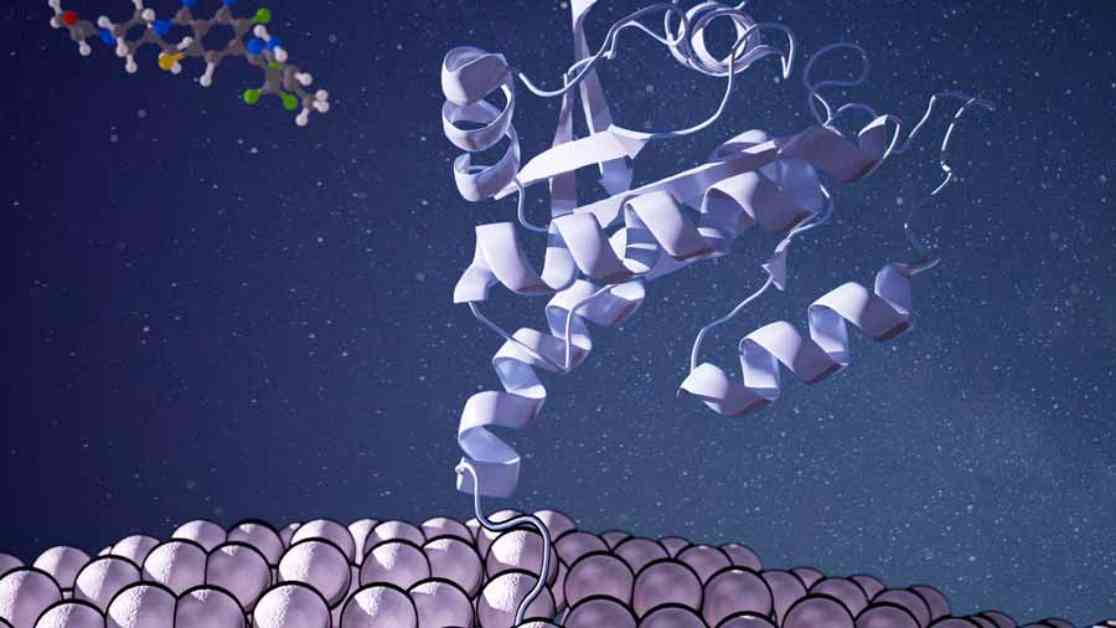UCSF scientists have made a groundbreaking discovery in the field of drug development by unlocking the secrets of targeting disease-causing enzymes known as GTPases. These molecular switches have long been considered “undruggable” due to their slippery exterior, making them a challenging target for modern drug discovery efforts. However, a recent study led by Kevan Shokat, PhD, and his team at UCSF has shed light on a new approach to successfully target these elusive enzymes.
GTPases play a crucial role in a wide range of diseases, including Parkinson’s and cancer, with one particular GTPase called K-Ras being responsible for up to 30% of all cancer cases. In 2013, Shokat and his colleagues identified a unique “pocket” on K-Ras where drugs could bind, leading to the development of nearly a dozen drugs targeting mutations in K-Ras. While this was a significant breakthrough, other GTPases remained out of reach until now.
The team’s innovative approach involved using a K-Ras mutation as a tool to make other GTPases more receptive to drugs. By testing a dozen drugs that target K-Ras on a handful of these molecular switches, they discovered new drug binding sites that were previously unknown. These findings, published in the journal Cell, open up a new realm of possibilities for developing therapies for diseases linked to GTPase dysfunction.
“We’ve known about the GTPases for decades but have lacked any way to reliably drug them,” said Shokat, a professor in the Department of Cellular and Molecular Pharmacology at UCSF. “This really puts all those GTPases on the map for drug discovery, so it’s possible to target them when they’re associated with disease.”
The hook that caught the mouthless fish
Our cells rely on networks of GTPases to regulate essential cellular processes such as molecule movement, cell growth, and division. When these molecular switches malfunction, it can lead to the development of various diseases. In their latest study, Shokat’s team, led by UCSF postdoctoral scholar Johannes Morstein, PhD, engineered the cancer-causing K-Ras mutation G12C into a group of GTPases to investigate potential drug interactions.
By utilizing G12C, which acts as a chemical “hook” on a protein, the researchers were able to identify which K-Ras drugs could bind to other GTPases that share subtle similarities with K-Ras. Surprisingly, some of the K-Ras drugs successfully bound to these GTPases with the help of G12C, even in the absence of the mutation. This breakthrough demonstrated the potential for targeting a broader range of GTPases for therapeutic purposes.
Freezing the switch between on and off
The team’s approach, known as chemical genetics, took advantage of the flexibility of GTPases to enable drugs to access a hidden pocket within the protein. This pocket, which is typically not visible in the standard drug discovery process, was revealed when the drugs bound to an intermediate state of the GTPases, effectively freezing them and preventing their activity.
“Since these GTPases switch between ‘on’ and ‘off’ states, the pocket is not usually visible, certainly not to the standard software used for drug discovery,” explained Shokat. “Instead, the drug binds to an intermediate state, freezing the GTPases and inactivating them.”
The researchers are now sharing their methods openly in hopes that other scientists will utilize them to develop drugs targeting GTPases associated with various diseases. Whether it’s a Rab GTPase linked to Alzheimer’s or a Rac GTPase involved in breast cancer, there is immense potential to advance drug discovery and improve patient outcomes.
“We’re hopeful that this approach can accelerate drug discovery and lead to new therapies for a wide range of diseases,” said Morstein. “By testing our ideas experimentally in the laboratory, we were able to uncover novel drug binding sites that were previously unknown, paving the way for future research in this field.”
Future implications and collaborations
The groundbreaking findings from the UCSF study have significant implications for the field of drug development and precision medicine. By targeting a diverse array of GTPases that play a role in various diseases, researchers can potentially unlock new treatment options for patients with conditions ranging from cancer to neurodegenerative disorders.
Collaborations with researchers at Lawrence Livermore National Lab and the National Cancer Institute’s RAS initiative have also been instrumental in advancing this research. The combined efforts of multidisciplinary teams have accelerated the progress in understanding GTPase biology and developing targeted therapies for these elusive molecular switches.
Funding and disclosures
The work conducted by the UCSF team was supported in part by federal grants and research funding. Several authors involved in the study are inventors on patents owned by UCSF related to GTPase-targeting small molecules. These disclosures highlight the potential for translating the team’s discoveries into tangible therapeutic interventions for patients in the future.
In conclusion, the groundbreaking research conducted by UCSF scientists has unlocked the secrets of targeting disease-causing enzymes known as GTPases, opening up new possibilities for drug development and precision medicine. By leveraging innovative approaches and collaborative efforts, researchers have identified novel drug binding sites on a diverse array of GTPases, paving the way for the development of targeted therapies for a wide range of diseases. This breakthrough holds promise for improving patient outcomes and advancing the field of molecular medicine.













